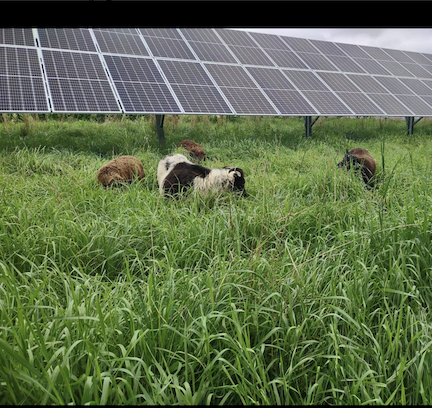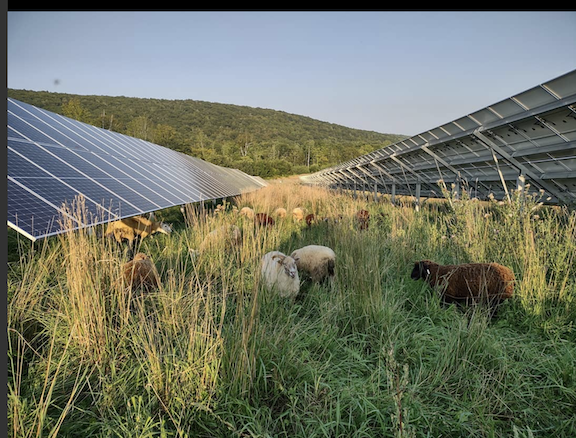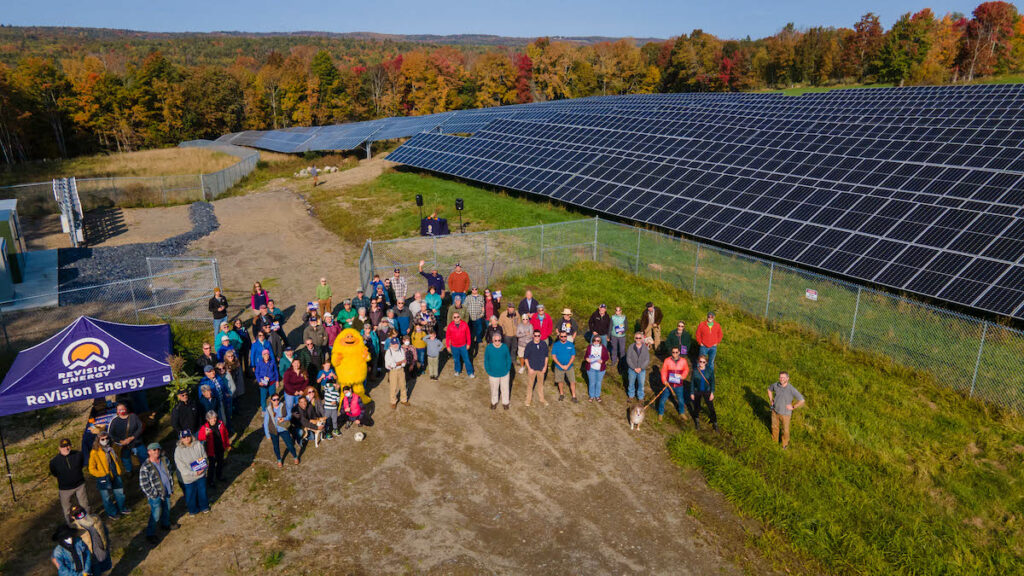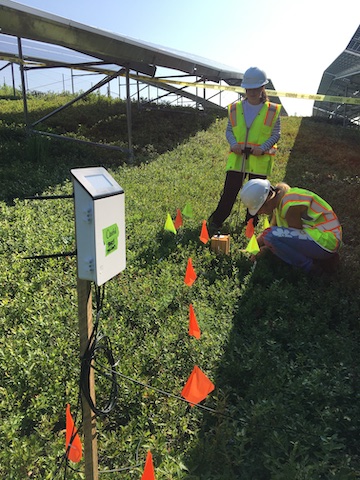By Tim King
It’s hard to keep up with the rapid expansion of commercial solar installations being developed in the Maine countryside. In January of last year, the Portland Press Herald reported that BNRG/Dirigo Solar, a venture of companies based in Portland, Maine, and Ireland, has 36 active projects in Maine, with 10 under construction.

“We currently have about a dozen projects under construction in Maine, with several expected to reach operation in early 2022 and others mid-year,” Keith Hevenor, of Boston-based Nexamp, said in mid-December 2021. “In addition, we have approximately two dozen projects in various stages of development that will come online in the next 12 to 18 months.”
Some of that development is being referred to by the recently coined term “agrivoltaics.” Shepherd Michael Dennett, of Crescent Run Farm in Jefferson, Maine, is one of the first Maine farmers to catch the agrivoltaics wave.
Dennett had contracts to graze four different solar installations with his flock of 20 ewes last season.
“As of right now, I am the only practitioner of solar grazing in the state,” he said. “I suspect this will change in 2022.”
Becoming Maine’s first solar grazer wasn’t easy.
“By the end of 2019, legislative changes at the state level had created a solar gold rush,” Dennett said. “The hunt was on. I spent hours scouring town meeting minutes, local newspapers and other resources hunting for projects of solar developers who were awarded permits. Then I started cold calling. Every time I left an unanswered message, was told no, or was strung along, my interest grew.
“I was fortunate to connect with Dirigo Solar, out of Portland, early in the process,” he continued. “They showed immediate interest, supported me on a business grant through Maine Farmland Trust, and hung in there with me while I worked out the kinks. I recently completed a graze of their 31-acre array in Augusta — now operated by their partner BNRG.”
To move sheep from one solar array to the next Dennett uses a 16-foot livestock trailer with a capacity for 22 ewes. He likes the small trailer because of its maneuverability, but he believes he will eventually need a 60-ewe-capacity trailer to make sheep transportation economically successful.
He hauls water to his sheep by truck in large plastic water cubes, which he fills at nearby boat landings, and visits his sheep twice per week. At a site, he checks his mineral blocks and adjusts the paddocks hemmed in by the solar company’s permanent perimeter fence and his portable electric netting, which is electrified by his own solar energizer.
“I’m paid on a per acre per year basis to keep the grass below the leading edge of the solar panels,” he said. “Shading by grass quickly impacts the production of a portion of the array. One of the largest operating costs for an array is grass abatement. Machines throw rocks, kick up dust and struggle to fit in between the equipment. Additionally, it’s hard to mow under the panels. Sheep are superior mowers and, when managed correctly, perform in a way that satisfies the solar developer and enhances the ecological health of land.”

One reason Dennett became the first solar grazer in Maine is because he’s a bit of a bulldog. Every time some company said no to him he became more determined to get to yes. But he had another motivation.
Ryan Dennett, Michael’s wife and MOFGA’s director of farmer programs, said, “In deciding to purchase our own home, my husband and I knew we wouldn’t be able to purchase the acreage needed to support our current sheep flock, let alone our future aspirations.” She said that the ability to graze solar installations, and be paid to do so, was a huge factor in their ability to access land and grow a viable farm. From 2014 to 2019, they managed another farm on large acreage and grew their flock there.
So, the Dennetts, who own 18 acres, including 4 acres of fields, had sheep but not enough land. Not only did the land under the solar panels solve that problem, it provided extra income that made shepherding more profitable. There was a third benefit.
“The solar installations that we graze are sited on agricultural land that hasn’t been utilized in years and it’s satisfying to us to be able to bring these fields back into production,” Ryan said. “I’ll add that our sheep have never looked better than they did this year. Forage grows really well under the panels and the sheep flourished with ample access to shade.”
Unlike Michael, MOFGA-certified organic vegetable farmer Peter Curra didn’t seek out Maine’s burgeoning solar industry. Peter and his wife, Susan, began farming in Knox in 1966. Before she passed on the couple created a trust.
“My wife and I engaged an attorney specializing in setting up trusts, which in our case is a dynasty trust. That means this place stays in our family in perpetuity. The trust is actually the legal entity and is governed by family-member trustees,” Curra said.
When the Curra family established their trust they didn’t imagine a commercial solar installation as part of the arrangement. In fact, Curra was initially opposed to it in 2018 when a neighbor, who worked for the solar company ReVision Energy, suggested it.
“Later on … I remembered I had a piece of pasture land I used when my milkers were still here,” Curra recalled. So, he set up a site inspection.
Curra could meet three of ReVision’s requirements: the site had to be in a wide-open area; there had to be a three-phase electrical line nearby; and the property had to be debt-free. He was initially unable to meet a fourth condition. An engineering firm, hired by ReVision, discovered that a portion of the site’s soils indicated that it was a wetland.
“A fellow from ReVision called me and said they weren’t interested in that piece of property but questioned if we had anything else,” Curra said. “So I polled my kids and explained the situation to them and collectively we agreed to offer the site where the array ended up.”

The site that the family settled on is a 10-acre field, a portion of which is perennially too wet to make hay, but not a wetland. After coming to a lease agreement, which involved hiring a lawyer to carefully review the 39-page contract, construction began.
“The key points in our agreement are the addition of an escalator clause which kicks in annually and a well spelled out decommissioning provision which requires that everything that ReVision brought here to enable the successful operation of the solar system be removed. It is also understood that as the technology advances it will be incorporated in our system. ReVision did orally promise me, and spelled out in its entirety, that when the time for it to cease operation [comes], they will remove everything below- and above-ground and try to return it to its original state, except for the replacement of trees,” Curra said. “In addition to the agreement for the 25-year lease, ReVision has the option of two additional five-year leases. Perhaps the most important part of this is that the lease creates a financial legacy for my kids and their kids.”
The commercial solar arrays allow the Curra family to keep a farm for generations to come. There is another aspect of the ReVision Energy array at Curra Family Farm that brings him satisfaction. “We are the first community solar project in Maine,” said Curra.
Holly Noyes, of ReVision Energy, said that their company put together a group of small investors to create the community solar project. The electricity generated at Curra Family Farm is fed into the grid and offsets the electricity used by each of the owners. ReVision also installed the solar electric panels at MOFGA’s Common Ground Education Center in Unity and hosts three of Michael Dennett’s solar grazing projects.
The ReVision project at Curra Family Farm is probably considered a “co-location” solar project based on definitions developed by the Final Report of the Agricultural Stakeholder Group released in January 2022. Co-location projects “involve siting a more conventional solar installation on a portion of farmland, while retaining other farmland for agricultural use,” according to the report. The Maine Governor’s Energy Office and the Maine Department of Agriculture, Conservation and Forestry convened the stakeholder group to make policy recommendations to balance the need to protect Maine’s current and future farmland with the need to develop sources of renewable solar energy.
The solar arrays under which Michael grazes his sheep fall under the report’s definition of “dual-use” in that “primary agricultural activities (such as animal grazing and crop/vegetable production) are maintained simultaneously on the farmland.”
Boston-based BlueWave Solar’s project installed on 10 acres in Rockport last summer is another example of dual-use.
Lily Calderwood, the Extension wild blueberry specialist at the University of Maine, Orono, is partnering with BlueWave, Navisun LLC, CS Energy, the landowner and the farmer to gather data on the short- and long-term effects of solar array construction on wild blueberry plants and the feasibility of continuing commercial construction.
“The solar developer agreed to test out three methods of construction (careful, mindful and standard) in order to identify ways to install the solar array with little damage to future wild blueberry production,” Calderwood said. “Under these three construction methods, research includes monitoring plant health and productivity using photosynthetic active radiation sensors to measure sunlight penetration, plant development measures including emergence date, bud, flower and fruit counts, plant heights, crop cover, and pest scouting.”

“Dr. Calderwood’s research ought to give us some really interesting data over the next few years,” Ryan Walker, of BlueWave, said in late December. “We are also looking at doing a 5-acre trial with vegetables under solar on a project that we are developing in Benton. We are still in the process of figuring out exactly how this would work and are looking for a farming partner for the crop operation.”
Michael Dennett will bring his sheep to graze the portion of the Benton solar array not planted to vegetables. Although nationally there is an example or two of full-scale solar-vegetable dual-use projects, Ryan Dennett, who works with beginning farmers in her position at MOFGA, struggles to imagine relationships between large-scale solar arrays and small-acreage farmers.
“I’m not sure how useful access to land under large arrays would be for beginning crop farmers,” she said. “We see most new farmers in our network growing intensively on small acreage, and I doubt that solar companies want to manage relationships with the number of small farmers that would be needed to utilize all of the acreage in an array.”
“However, perhaps there is an opportunity for an organization, where a cooperative of farmers or nonprofit incubators could take on that management and have a point person manage the relationship with the developer,” she continued.
Both Ryan Dennett and Dave Asmussen, of Blue Bell Farm in Bowdoinham, expressed concerns that large, on-the-ground arrays may compete for farmland that is currently being leased to harvest hay or graze cattle.
Asmussen, whose family farm has a 9.76-kilowatt, 32-panel rooftop array, is among a group of solar proponents, including many members of the governor’s stakeholder committee, who are working to avoid a gold rush and to make an orderly transition to renewables in regard to land use.
“My hope is that with a bit more forethought on solar we can avoid some of the pitfalls we’ve experienced from other technological transitions,” he said.
By becoming a member of the comprehensive planning committee in Bowdoinham, Asmussen hopes to help craft that orderly transition.
“I am working to add language to the land use ordinance to address solar installations,” he said. “As of December, there is zero reference to solar in the ordinances and I imagine that many rural towns are similar.”
Asmussen would like to see more emphasis on rooftop installations on homes, small businesses and farms as well as elevated installations in parking lots and on farms. That, he said, would take some of the pressure off agricultural land.
“Where we put solar arrays is an important topic for everyone to consider as we cut our carbon use and move into a hopefully cleaner energy world,” he said.
About the author: Tim King is a produce and sheep farmer, a journalist and cofounder of a bilingual community newspaper. He lives near Long Prairie, Minnesota.
